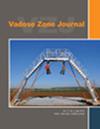The value of soil temperature data versus soil moisture data for state, parameter, and flux estimation in unsaturated flow model
IF 2.8
3区 地球科学
Q3 ENVIRONMENTAL SCIENCES
引用次数: 0
Abstract
This synthetic study explores the value of near-surface soil moisture and soil temperature measurements for the estimation of soil moisture and soil temperature profiles, soil hydraulic and thermal parameters, and latent heat and sensible heat fluxes using data assimilation (ensemble Kalman filter) in combination with unsaturated zone flow modeling (HYDRUS-1D), for 12 United States Department of Agriculture soil textures in a homogeneous and bare soil scenario. The soil moisture profile is estimated with a root mean square error (RMSE) of 0.04 cm3/cm3 for univariate soil temperature assimilation and 0.01 cm3/cm3 for univariate soil moisture assimilation. Soil temperature assimilation performs better for soils with higher clay content compared to soils with higher sand content. The latent and sensible heat fluxes are estimated with smaller RMSE for univariate soil temperature assimilation compared to univariate soil moisture assimilation for 8 out of 12 soil types. As the climate condition changes from hot semi-arid to sub-humid climate, the soil moisture assimilation performs better for high permeable soil but worse for low permeable soil. In summary, the findings suggest that for most soil texture classes, assimilating soil temperature in vadose zone models is skillful to improve latent heat flux, soil moisture profile, and soil hydraulic parameters. Joint assimilation with soil moisture can further enhance the accuracy of the model outputs for all range of soil texture and climate conditions.土壤温度数据与土壤湿度数据在非饱和流模型的状态、参数和通量估算中的价值对比
本合成研究探讨了近地表土壤水分和土壤温度测量值在估算土壤水分和土壤温度剖面、土壤水力和热力参数以及潜热和显热通量方面的价值,其方法是利用数据同化(集合卡尔曼滤波器)结合非饱和带流动建模(HYDRUS-1D),针对美国农业部在均质裸露土壤情景下的 12 种土壤质地进行估算。单变量土壤温度同化估算出的土壤水分剖面均方根误差(RMSE)为 0.04 cm3/cm3,单变量土壤水分同化估算出的土壤水分剖面均方根误差(RMSE)为 0.01 cm3/cm3。与含沙量较高的土壤相比,粘土含量较高的土壤温度同化效果更好。与单变量土壤水分同化相比,单变量土壤温度同化对 12 种土壤类型中 8 种的潜热通量和显热通量估算的均方根误差较小。随着气候条件从炎热半干旱气候向亚湿润气候转变,土壤水分同化在高渗透性土壤中表现更好,但在低渗透性土壤中表现较差。总之,研究结果表明,对于大多数土壤质地类别,在渗流带模型中同化土壤温度可有效改善潜热通量、土壤水分状况和土壤水力参数。在各种土壤质地和气候条件下,与土壤水分联合同化可进一步提高模型输出的准确性。
本文章由计算机程序翻译,如有差异,请以英文原文为准。
求助全文
约1分钟内获得全文
求助全文
来源期刊

Vadose Zone Journal
环境科学-环境科学
CiteScore
5.60
自引率
7.10%
发文量
61
审稿时长
3.8 months
期刊介绍:
Vadose Zone Journal is a unique publication outlet for interdisciplinary research and assessment of the vadose zone, the portion of the Critical Zone that comprises the Earth’s critical living surface down to groundwater. It is a peer-reviewed, international journal publishing reviews, original research, and special sections across a wide range of disciplines. Vadose Zone Journal reports fundamental and applied research from disciplinary and multidisciplinary investigations, including assessment and policy analyses, of the mostly unsaturated zone between the soil surface and the groundwater table. The goal is to disseminate information to facilitate science-based decision-making and sustainable management of the vadose zone. Examples of topic areas suitable for VZJ are variably saturated fluid flow, heat and solute transport in granular and fractured media, flow processes in the capillary fringe at or near the water table, water table management, regional and global climate change impacts on the vadose zone, carbon sequestration, design and performance of waste disposal facilities, long-term stewardship of contaminated sites in the vadose zone, biogeochemical transformation processes, microbial processes in shallow and deep formations, bioremediation, and the fate and transport of radionuclides, inorganic and organic chemicals, colloids, viruses, and microorganisms. Articles in VZJ also address yet-to-be-resolved issues, such as how to quantify heterogeneity of subsurface processes and properties, and how to couple physical, chemical, and biological processes across a range of spatial scales from the molecular to the global.
 求助内容:
求助内容: 应助结果提醒方式:
应助结果提醒方式:


